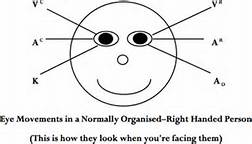Two weeks ago I joined a four day training on a combination of NLP (Neuro Linguistic Programming) and Bio-Energetic Therapy. Highly interesting and for me a personal challenge, as I tend to be very much a “head” person and less a “body” person.
 Most people who have heard of NLP immediately start talking about eyes and eye movements. How these movements can tell what you think.
Most people who have heard of NLP immediately start talking about eyes and eye movements. How these movements can tell what you think.
Well, these movements may not tell what you think, but certainly the process of how you think.
Good communication starts with a good “rapport” or “connection” with the other person. If you understand their way of thinking, you may understand the person you are talking to better and your level of communication goes up one notch.
For those who are interested some short introduction in the meaning of the movement of the eyes:
Watch when you are talking to someone and you ask a question. You may notice that the eyes move away from you. This means that the other person engages in an Inner Process. The person tries to get to the information he needs for the answer.
When we process information, we can do this in three different ways:
ways:
- Visual
- Auditive
- Kinestetic.
The eye movements show where the information is stored that people deem important or needed in the conversation. The eyes move to the “place” the information is to be found. You can also see the moments a person is talking to himself or recalls memories.
I will explain how it works (by the way: when I talk about “looking left up” I mean: for you left up while watching the face of the person opposite you).
Visual Construction: (the person looks “left up”) the eyes travel there when somebody tries to construct an image. This means that there is no earlier memory of something similar. Examples of questions to make somebody go in visual construction:
- How would your living room look in the color green (or any color it is not now)?
- How do you spell my name backwards?
- Imagine a blue triangle in a red square
Visual Memory: (the persons looks “right up”). When ever we try to picture memories or get back images we have seen before, the eyes travel to our “visual memory storage place”. Examples of questions to make somebody go in visual memory:
- What color has your frontdoor?
- How does the front of your house look like?
- What does your best friend look like?
Auditive construction: (the person looks to the “left at ear-level”). When we construct sounds we have never heard before the eyes travel left. Examples of questions to make somebody go in auditive construction:
- How load can 20 people shout all together?
- What does a cry from a witch sound like?
- How would your mobile phone ringtone sound under water?
Auditive Memory: (the person looks to the “right at ear-level”). When we remember sounds and voices we have heard before or we have said to ourselves. Examples of questions to make somebody go in auditive memory:
- What does the voice of my best friend sound like?
- How does your favorite song as a child go?
- What is the last sentence you just said?
Kinestetic: (the person looks “down to the left”). When we get in touch with our feelings. Examples of questions to make somebody go in kinestetic mode:
- How does it feel to caress a dog?
- How does it feel to take a warm shower,
- How does a cup of fresh coffee smell?
Auditive Digital: (the person looks “down to the right”). When we talk to ourselves and we go into an internal dialogue. Examples of questions to get somebody in auditive digital:
- Recite a poem silenty to yourself.
- How does a conversation with yourself go?
In what way can you use this information and will it help us understand the other person better?
Well, obviously you will learn about their process of thinking and their preferences for auditive or visual. This may help you while explaining something. If somebody has a visual preference, you beter “paint the picture” of what you want to come across.
Let me give an example of what you could see if you ask the following question: How does a lion in a pink apron look like?
Imagine that the eyes movements are :
- down to the right (auditive digital)
- up to the right (visual memory)
- up to the left (visual construction)
- down to the left. (kinestetic)
This means that the person first repeats the question to himself (auditive preference), then collects images of a lion and an apron, then constructs a lion in a pink apron and finally has a feeling about this. You could ask for their feeling directly, as you know that they have one.
If somebody answers a question first going “up or ear-level to the left” with the eyes, you know there are no existing images involved in the answer and that there is only construction there and no experience. Somebody may be making something up then (or lying indeed).
Please share your experience with NLP or eye movements and tell us how you make your communciation work well. Use the comments section and let us know how you think….
If you want to receive these blog-posts automatically, please subscribe via the button and you will receive them bi-weekly in your inbox.
Esther Celosse
Follow-it

I had this training 10 years ago and remember it as it was told to me yesterday. Along with “Matching”, “Emphatic listening” etc these are powerful communication tools.
Dear Ma’am,
This article is very interesting & explains many different perspectives as to how you can better the communication between persons. I gonna try communicating with images & pictures & hope to see the difference.
Thanks & Regards,
Ridit Raj Dutta.
+91 99300 70683.